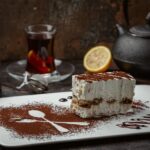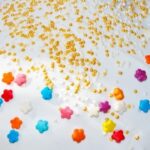Gelatin cake decorations have become increasingly popular in the world of baking, allowing for a new level of creativity and artistry in cake design. In this article, we will explore the growing trend of using gelatin decorations and the unique opportunities it presents for creating stunning, intricate designs on cakes. From flowers to leaves to other elaborate shapes, gelatin decorations offer a wide range of possibilities to elevate your cake decorating skills.
Creating gelatin cake decorations requires specific tools and ingredients to achieve the desired results. We will provide you with a detailed list of what you need, including different types of gelatin, shaping and coloring tools, and other essential materials. With our step-by-step instructions, you will be able to master the art of making gelatin decorations, learning valuable tips on coloring, molding, and setting the gelatin effectively.
Not only will we guide you through the process of making gelatin decorations, but we will also delve into the various shapes and designs that can be achieved with this versatile medium. Whether it’s delicate floral arrangements or intricate patterns, we will explore ways to create visually stunning decorations that are sure to impress. So get ready to unleash your creativity and take your cake decorating skills to new heights with the art of gelatin cake decorations.
Important Tools and Ingredients
When it comes to creating gelatin cake decorations, having the right tools and ingredients is essential. Here is a detailed list of what you will need to get started on making beautiful and intricate gelatin decorations for your cakes.
Gelatin
The type of gelatin you use will have a significant impact on the final result of your decorations. It is important to use unflavored, powdered gelatin for making cake decorations. This type of gelatin allows for better control over the flavor and color of the decorations.
Tools for Shaping and Coloring
To create various shapes and designs with gelatin, you will need specific tools such as small cutters, molds, and shaping tools. These can include flower cutters, leaf veiners, and ball tools to help shape the gelatin into intricate designs. Additionally, having food coloring gels or powders on hand will allow you to add vibrant colors to your creations.
Other Necessary Materials
In addition to gelatin and shaping tools, you will also need a few other materials such as a small paintbrush for adding details and edible luster dust for adding shimmer and shine to your decorations. Having these materials on hand will ensure that you have everything you need to create stunning gelatin cake decorations.
By having the right tools and ingredients at your disposal, you can delve into the world of creating beautiful gelatin cake decorations with confidence. With some practice and creativity, you can elevate the look of your cakes with custom-made gelatin decorations that are sure to impress any crowd.
Step-by-Step Instructions for Making Gelatin Decorations
Gelatin cake decorations are a fun and creative way to add a unique touch to any cake. Whether you’re a professional baker or just enjoy baking as a hobby, learning how to make gelatin cake decorations can take your cake designs to the next level. Below is a comprehensive guide on the process of making gelatin decorations, including tips on coloring, molding, and setting the gelatin.
To start making gelatin decorations for cakes, you will need a few important tools and ingredients. Firstly, you will need unflavored gelatin, which can usually be found in the baking aisle of most grocery stores.
You will also need water, food coloring or gel food coloring, small paintbrushes for detailing, and molds or cutters in various shapes such as flowers, leaves, and other designs. Additionally, having a heatproof bowl, small saucepan, and an offset spatula will be useful for shaping and handling the gelatin.
The first step in making gelatin cake decorations is to prepare the gelatin mixture. This involves blooming the gelatin by sprinkling it over cold water and allowing it to soften before heating it until fully dissolved. Once dissolved, you can add food coloring to achieve your desired color for the decorations.
Be sure to work quickly with caution when handling hot liquid gelatin to avoid burns. Once colored appropriately set the molds aside to cool either at room temperature or refrigerate depending on your settings once they are completely set simply pull them out of their mold gently in case you use metal ones considering they scratch easily place them carefully onto wax paper until ready for use.
| Tools | Ingredients |
|---|---|
| Small paintbrushes | Unflavored Gelatin |
| Molds or cutters | Water |
| Heatproof bowl | Food Coloring |
Creating Different Shapes and Designs
Gelatin cake decorations offer a wide range of creative possibilities, allowing bakers to add intricate and eye-catching designs to their cakes. One of the most exciting aspects of working with gelatin in cake decorating is the ability to create a variety of shapes and designs, from delicate flowers to elegant leaves and other elaborate decorations. In this section, we will explore the various techniques for shaping and designing gelatin decorations to elevate your cake decorating skills.
When it comes to shaping gelatin decorations, there are several methods that can be used. One popular technique is molding the gelatin using specialized molds, which come in a variety of shapes and sizes. These molds allow you to create finely detailed decorations such as roses, butterflies, or even geometric patterns. Additionally, some decorators choose to freehand their designs by using small shaping tools or even just their fingers to sculpt the gelatin into unique shapes.
Another important aspect of creating different shapes and designs with gelatin is the use of different colors and flavors. By adding edible food coloring or flavor extracts to the gelatin mixture, decorators can achieve a wide spectrum of vibrant colors and enhance the overall look and taste of the cake. It’s important to carefully consider how colors and flavors will interact with each other when planning out your design, ensuring that they complement each other harmoniously.
Incorporating different shapes and designs made from gelatin into cake decorating requires attention to detail and precision. Using these techniques effectively can take your cake decorating skills to new heights, creating stunning visual effects that are sure to impress any audience.
| Gelatin Decoration Technique | Description |
|---|---|
| Molding | Using specialized molds to create detailed decorations such as flowers or geometric patterns. |
| Freehand Sculpting | Creating unique shapes by hand using small tools or fingers. |
| Coloring & Flavoring | Adding edible food coloring or flavor extracts for vibrant colors and enhanced taste. |
Using Gelatin Decorations on Cakes
Placement of Gelatin Decorations
When it comes to using gelatin decorations on cakes, placement is key. It’s important to strategically place the decorations in a visually appealing and balanced way. One tip for effective placement is to envision the overall design of the cake and plan where each decoration will go before actually placing them. This can help create a cohesive and harmonious look.
Storage and Handling
After creating your beautiful gelatin decorations, it’s crucial to handle them with care and store them properly until they are ready to be used. Gelatin decorations should be stored in a cool, dry place away from direct sunlight and moisture to prevent them from melting or losing their shape. Additionally, handling the decorations gently when placing them on the cake is essential to avoid any damage.
Ensuring Stability
To ensure that gelatin decorations stay in place on the cake, it’s helpful to use a small amount of frosting or icing as adhesive. This will help secure the decorations onto the surface of the cake and prevent them from shifting or sliding off. Another tip for stability is to refrigerate the cake after adding the gelatin decorations, as this can help them adhere better and maintain their shape.
By carefully considering placement, storage, and stability, you can effectively incorporate gelatin decorations into your cake designs and create stunning confections that are sure to impress.
Coloring and Flavors
When it comes to creating gelatin cake decorations, coloring and flavors play a crucial role in enhancing the overall look and taste of the cake. The good news is that there are various ways to color and flavor gelatin to create different effects and customize it according to your preferences.
One popular method for coloring gelatin is to use food coloring. Gel food colors work best as they are highly concentrated and can be added drop by drop until the desired color is achieved. It is important to note that water-based food coloring may affect the consistency of the gelatin, so oil-based or powdered colors are preferred for this purpose.
In addition to coloring, adding flavor to gelatin can take your cake decorations to the next level. One simple way to introduce flavor is by using flavored gelatin mixes. These come in a variety of options such as fruit flavors, citrus, and even unique combinations like mango-pineapple or raspberry-lemon.
You can also add extracts such as vanilla, almond, or citrus for an extra kick of flavor. Just be mindful of the balance between color and flavor, ensuring that both complement each other rather than overpowering one another.
Another method for infusing flavor into gelatin is by using fruit juices or purees. Simply replace some of the water in the gelatin recipe with your chosen juice or puree for a burst of natural fruity flavor.
This not only adds complexity to the taste but also contributes to vibrant colors if using deeply colored fruits like berries or pomegranate. Ultimately, experimenting with different color and flavor combinations will allow you to unleash your creativity and produce stunning gelatin cake decorations that elevate the visual appeal and taste of your cakes.
Troubleshooting
When it comes to making gelatin cake decorations, there are a few common issues and challenges that may arise during the process. Being able to troubleshoot these problems effectively can make a big difference in the success of your decorations. Here are some tips for addressing these challenges:
- Setting Issues: One common problem when making gelatin decorations is not getting the right texture or consistency. If your gelatin isn’t setting properly, double-check that you’re using the correct ratio of gelatin to liquid. Additionally, ensure that you’re allowing enough time for the gelatin to set in the refrigerator before attempting to remove or work with it.
- Shaping Problems: Sometimes, shaping gelatin decorations can be tricky, especially when trying to create intricate designs. If you’re having trouble shaping the gelatin into the desired form, try working with it at different temperatures. Warmer gelatin is more pliable and easier to shape, while colder gelatin is firmer and better for holding its form.
- Coloring Challenges: Getting vibrant and even colors on your gelatin decorations can also be a challenge. To ensure that your colors turn out bright and consistent, make sure to use high-quality food coloring and mix it thoroughly into the liquid gelatin before setting.
By being aware of these potential issues and knowing how to address them, you’ll be better equipped to successfully create stunning and professional-looking gelatin cake decorations.
Overall, troubleshooting any problems that may arise during the process of making gelatin cake decorations requires attention to detail and patience. With practice and persistence, you’ll be able to overcome these challenges and create beautiful and intricate designs that will take your cake decorating skills to the next level.
Inspiration and Creative Ideas
In conclusion, gelatin cake decorations offer a versatile and creative way to enhance the look and taste of any cake. By following the step-by-step instructions for making gelatin decorations and utilizing the right tools and ingredients, anyone can create beautiful and intricate designs to adorn their cakes. From flowers to leaves and other intricate shapes, the possibilities are endless when it comes to creating stunning gelatin cake decorations.
Coloring and flavors play a significant role in enhancing the overall look and taste of gelatin cake decorations. With a variety of options available, such as vibrant food colors and flavor extracts, it’s easy to customize the gelatin decorations to suit any occasion or theme. Additionally, troubleshooting common issues that may arise during the process can help ensure successful results when creating gelatin cake decorations.
Overall, showcasing examples of stunning gelatin cake decorations provides inspiration for readers looking to elevate their cake decorating skills. Whether it’s a special occasion or simply a desire to explore new techniques in baking, incorporating gelatin decorations into cake design offers an exciting opportunity for creativity. With dedication and practice, anyone can master the art of creating beautiful and unique gelatin cake decorations.
Frequently Asked Questions
How Do You Use Gelatin in Cake Decorations?
Gelatin can be used in cake decorations by mixing it with water to create a moldable, edible substance that can be shaped into various designs. It can also be mixed with food coloring to add vibrant colors to the decorations.
How Do You Make Gelatin Bubbles for Cake Decorating?
To make gelatin bubbles for cake decorating, you would mix unflavored gelatin with water, heat it up, and then blow air into it using a straw to create bubbles. Once the bubbles have set, they can be attached to the cake for a whimsical touch.
What Gelatin Do You Use for Jelly Art?
When creating jelly art, it’s important to use agar-agar instead of traditional gelatin. Agar-agar is derived from seaweed and is vegetarian-friendly, making it suitable for jelly art where vibrant colors and intricate designs are desired.

Welcome to my blog about home and family. This blog is a place where I will share my thoughts, ideas, and experiences related to these important topics. I am a stay-at-home mom with two young children. I hope you enjoy reading it! and may find some helpful tips and ideas that will make your home and family life even better!





